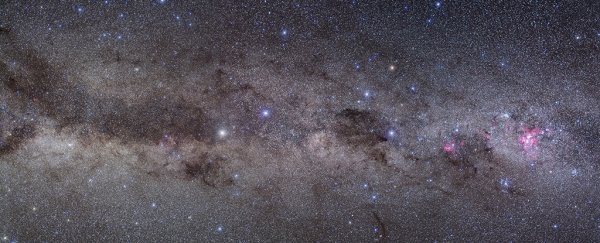When you're preparing for any journey it helps to know how long it'll take, and even more so when we're talking about the vast distances of space.
Now a couple of physicists have tried to calculate more precisely how long it would take us to get to other star systems in our galaxy, using existing spacecraft.
They looked specifically at four unmanned space probes already launched by NASA, but these figures also give us an idea of how long it might take humankind to get out beyond the reaches of the Solar System.
And it looks like future space travellers are going to have to settle in for the long haul: it could be tens of thousands of years before one of these probes comes anywhere close to another star system, and several million billion years before there's a direct hit.
"The timescale for the collision of a spacecraft with a star is of order 1020 [one hundred quintillion] years, so the spacecraft have a long future ahead of them," write the researchers in their paper.
To get to their conclusions, Coryn Bailer-Jones from the Max Planck Institute for Astronomy in Germany, and Davide Farnocchia from the NASA Jet Propulsion Laboratory, studied the latest data from the Gaia space observatory.
Gaia's most up-to-date map has the locations of some 7.2 million stars. They then combined that data with the projected paths of the Pioneer 10, Pioneer 11, Voyager 1 and Voyager 2 space probes, launched between the years 1972 and 1977.
Over the next million years, the results show these four probes will come reasonably close (in cosmic terms) to around 60 stars. They'll get relatively near around 10 stars in that time – but here "relatively near" means within 2 parsecs, which is more than 6 light-years… or more than 60 trillion kilometres, and almost 40 trillion miles.
To put that into perspective, Pluto's orbit only takes it out as far as just over 7 billion kilometres. So our probes will still be tens of thousands of times that distance from alien stars.
Pioneer 10 has the best chance of getting a reasonably close-up look at a star system first: it's expected to pass HIP 117795 in the Cassiopeia constellation in around 90,000 years. Even then it'll be 0.231 parsecs (around 7 trillion kilometres or 4 trillion miles) away.
Of course future space missions don't have to follow the path of these four probes – our closest star system, Alpha Centauri, is a mere 4.37 light-years or 1.34 parsecs away. At its current speed, Voyager 1 could make it there in less than 80,000 years.
These calculations have yet to be peer-reviewed but they give you some idea of the sheer scale of the galaxy, not to mention the entire Universe, and the kind of technology humankind will have to develop to get beyond our Solar System.
We might have to spend several generations in transit in order to reach the nearest stars, at least until scientists figure out how to develop the warp drives that have so far remained the stuff of sci-fi books and movies.
Some experts think it's possible that we could one day travel at close to the speed of light (and get to Alpha Centauri in four years or so), but this is all very much theoretical for the time being. In the meantime, perhaps we'd best just focus on Mars.
The research has yet to be published but is available on the pre-print server arXiv.org.
